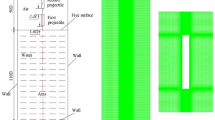Abstract
In this paper, the water-exit phenomenon has been studied experimentally and numerically. Based on the volume-of-fluid model and the Schnerr–Sauer cavitation model, the water-exit supercavitation around different shapes of cavitator projectiles is investigated using a dynamic mesh technology and three-dimensional six-degree-of-freedom method. The numerical results are compared with the experimental results obtained in our laboratory. Next, the effects of the cavitator shape on the characteristics of the projectile motion, breaking of the free surface, supercavitation size, and hydrodynamics of the water-exit supercavitation are analyzed. It was found that the hemispherical-nose projectile holds the best storage capacity and the longest displacement. The blunt disk-shaped nose projectile generates the maximum diameter of supercavity. The cavitation diameters of the conical-nose projectile and the hemispherical-nose projectile are relatively small.














Similar content being viewed by others
References
Logvinovich, G.V.: Hydrodynamics of Flows with Free Boundaries. Naukova Dumka, Kiev (1969)
Nair, V.V., Bhattacharyya, S.K.: Water entry and exit of axisymmetric bodies by CFD approach. J. Ocean Eng. Sci. 3, 156–174 (2018). https://doi.org/10.1016/j.joes.2018.05.002
Erfanian, M.R., Anbarsooz, M., Rahimi, N., Zare, M., Moghiman, M.: Numerical and experimental investigation of a three dimensional spherical-nose projectile water entry problem. Ocean Eng 104, 397–404 (2015). https://doi.org/10.1016/j.oceaneng.2015.05.024
Nguyen V.T., Ha C.T., Park W.G.: Multiphase flow simulation of water-entry and-exit of axisymmetric bodies. ASME 2013 International Mechanical Engineering Congress and Exposition, American Society of Mechanical Engineers, California, USA (2013). https://doi.org/10.1115/IMECE2013-64691
Zhang, J.Z., You, T.Q., He, Q.K., Wei, Y., Wang, C.: Numerical analysis of cavitation flow during vertical water exit of underwater vehicles. J. Adv. Mater. Res. 201–203, 2780–2784 (2011)
Wu, Q.G., Ni, B.Y., Bai, X.L., Cui, B., Sun, S.L.: Experimental study on large deformation of free surface during water exit of a sphere. Ocean Eng. 140, 369–376 (2017). https://doi.org/10.1016/j.oceaneng.2017.06.009
He, C.T., Wang, C., Min, J.X., Jin, D.Q., Huang, H.L.: Numerical simulation of early air-cavity of cylinder cone with vertical water-entry. J. Eng. Mech. 29(4), 237–243 (2012). (in Chinese)
Sun, Z., Cao, W., Wang, C.: Numerical investigations of hydrodynamic force acting on sphere during water entry. J. Vib. Shock 36(20), 165–172 (2017). https://doi.org/10.13465/j.cnki.jvs.2017.20.026. (in Chinese)
Zhang, C.X., Li, X.L., Liu, Y.Q.: Numerical investigation of water-exit cavity flow of missile with complex configuration. J. Syst. Simul. 28(6), 1321–1328 (2016). https://doi.org/10.16182/j.cnki.joss.2016.06.010. (in Chinese)
Kirschner, I.N., Fine, N.E., Uhlman, J.S., Gieseke, T.A., Kuklinski, R., Kring, D.C., Rosenthal, B.J., Varghese, A.N.: Supercavitation Research and Development. Undersea Defense Technologies, Waikiki, HI (2001)
Cameron, P., Rogers, P., Doane, J., Gifford, D.: An experiment for the study of free-flying supercavitating projectiles. ASME J. Fluids Eng. 133, 021303-1–9 (2011). https://doi.org/10.1115/1.4003560
Fedorenko, N.S., Kozenko, V.F., Kozenko, R.N.: Experiment study of the inertial motion of supercavitating models. In: Nesteruk, I. (ed.) Supercavitation, pp. 27–37. Springer (2011). https://doi.org/10.1007/978-3-642-23656-3_2
Baradaran, F.M., Nikseresht, A.H.: Numerical simulation of unsteady 3D cavitating flows over axisymmetric cavitators. Sci. Iran B 19(5), 1258–1264 (2012). https://doi.org/10.1016/j.scient.2012.07.013
Kim, S., Kim, N.: Integrated dynamics modeling for supercavitating vehicle systems. Int. J. Nav. Archit. Ocean Eng. 7(2), 346–363 (2015). https://doi.org/10.1515/ijnaoe-2015-0024
Shi, H.H., Hu, J.H., Zhou, H.L.: Experimental and theoretical analysis of water exit of a supercavity. Acta Aerodyn. Sin. 32(4), 544–550 (2014). https://doi.org/10.7638/kqdlxxb-2013.0008. (in Chinese)
Shi, H.H., Hu, Q.Q., Chen, B., Jia, H.X.: Experimental study of supercavitating flows induced by oblique and vertical water entry of blunt bodies. Explos. Shock Waves 35(5), 617–624 (2015). https://doi.org/10.11883/1001-1455(2015)05-0617-08
Shi, H.H., Zhou, Y.J., Jia, H.X., Zhu, B.B.: The effects of water depth and length-to-diameter ratio on drag coefficient and cavity shape of underwater supercavitating projectiles. Acta Armamentarii 37(11), 2029–2036 (2016). https://doi.org/10.3969/j.issn.1000-1093.2016.11.010. (in Chinese)
Shi, H.H., Gao, J.R., Jia, H.X., Hu, J.H., Zhou, Y.J., Chen, B.: Cavitating gas-liquid two-phase flow pattern in water exit of a high-speed body. J. Univ. Chin. Acad. Sci. 33(2), 271–276 (2016). https://doi.org/10.7523/j.issn.2095-6134.2016.02.020. (in Chinese)
Jia, H.X., Shi, H.H., Hu, J.H., Chen, B.: Experiments on water exit phenomenon of underwater launched projectiles with a supercavity. J. Ship Mech. 21(7), 814–820 (2017). https://doi.org/10.3969/j.issn.1007-7294.2017.07.003. (in Chinese)
Smith, L.M., Woodruff, S.L.: Renormalization-group analysis of turbulence. Annu. Rev. Fluid Mech. 30(1), 275–310 (1998). https://doi.org/10.1146/annurev.fluid.30.1.275
Schnerr, G.H., Sauer, J.: Physical and numerical modeling of unsteady cavitation dynamics. Fourth International Conference on Multiphase Flow (Vol. 1), New Orleans, USA (2001)
Zheng, Z.Y., Li, F.C., Li, Q., Kulagin, V.A.: Numerical study on the characteristics of natural supercavitation by planar symmetric wedge-shaped cavitators for rotational supercavitating evaporator. Sci. China Technol. Sci. 58(006), 1072–1083 (2015). https://doi.org/10.1007/s11431-015-5827-y
Zhang, X.W., Li, Q., Huang, L.: Analysis of drag reduction on super-cavitation projectile based on 6DOF. J. Project. Rock. Missiles Guid. 36(05), 109-111+141 (2016). https://doi.org/10.15892/j.cnki.djzdxb.2016.05.028. (in Chinese)
Lu, L.W.: Research on supercavitation flows’ characteristics of projectiles with complex structure in water exit and entry. Master Thesis, Zhejiang Sci-Tech University, Hangzhou, China (2019) (in Chinese)
Kleefsman, K.M.T., Fekken, G., Veldman, A.E.P., Iwanowski, B., Buchner, B.: A volume-of-fluid based simulation method for wave impact problems. J. Comput. Phys. 206(1), 363–393 (2005). https://doi.org/10.1016/j.jcp.2004.12.007
Kleefsman, K.M.T., Fekken, G., Veldman, A.E.P., Iwanowski, B.: An improved volume-of-fluid method for wave impact problems. In: Proceedings of 14th International Offshore and Polar Engineering Conference, pp. 334–341. International Society of Offshore and Polar Engineering, California, USA (2004)
May, A.: Water entry and the cavity-running behavior of missiles. Final Technical Report, SEAHAC TR75-2, Naval Sea Systems Command, Arlington, VA, USA (1975)
Acknowledgements
This work was supported by the Zhejiang Provincial Natural Science Foundation of China (Grant No. LY16A020003).
Author information
Authors and Affiliations
Corresponding author
Additional information
Communicated by C.Y. Wen.
Publisher's Note
Springer Nature remains neutral with regard to jurisdictional claims in published maps and institutional affiliations.
Rights and permissions
About this article
Cite this article
Shi, H.H., Zhou, D.H., Lu, L.W. et al. On the water exit of supercavitating projectiles with different head shapes. Shock Waves 31, 597–607 (2021). https://doi.org/10.1007/s00193-021-01025-7
Received:
Revised:
Accepted:
Published:
Issue Date:
DOI: https://doi.org/10.1007/s00193-021-01025-7




